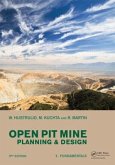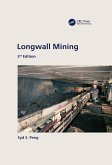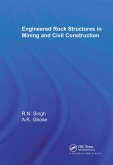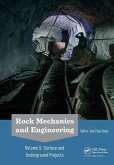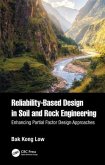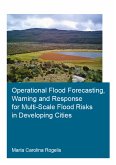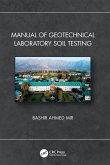Guidelines for Evaluating Water in Pit Slope Stability
Herausgeber: Beale, Geoff; Read, John
Guidelines for Evaluating Water in Pit Slope Stability
Herausgeber: Beale, Geoff; Read, John
- Broschiertes Buch
- Merkliste
- Auf die Merkliste
- Bewerten Bewerten
- Teilen
- Produkt teilen
- Produkterinnerung
- Produkterinnerung
Guidelines for Evaluating Water in Pit Slope Stability is a comprehensive account of the hydrogeological procedures that should be followed when performing open pit slope stability design studies. Created as an outcome of the Large Open Pit (LOP) project, an international research and technology transfer project on the stability of rock slopes i
Andere Kunden interessierten sich auch für
![Open Pit Mine Planning and Design, Two Volume Set & CD-ROM Pack Open Pit Mine Planning and Design, Two Volume Set & CD-ROM Pack]() William A HustrulidOpen Pit Mine Planning and Design, Two Volume Set & CD-ROM Pack192,99 €
William A HustrulidOpen Pit Mine Planning and Design, Two Volume Set & CD-ROM Pack192,99 €![Longwall Mining, 3rd Edition Longwall Mining, 3rd Edition]() Syd PengLongwall Mining, 3rd Edition114,99 €
Syd PengLongwall Mining, 3rd Edition114,99 €![Engineered Rock Structures in Mining and Civil Construction Engineered Rock Structures in Mining and Civil Construction]() Raghu N. SinghEngineered Rock Structures in Mining and Civil Construction116,99 €
Raghu N. SinghEngineered Rock Structures in Mining and Civil Construction116,99 €![Rock Mechanics and Engineering Volume 5 Rock Mechanics and Engineering Volume 5]() Rock Mechanics and Engineering Volume 561,99 €
Rock Mechanics and Engineering Volume 561,99 €![Reliability-Based Design in Soil and Rock Engineering Reliability-Based Design in Soil and Rock Engineering]() Bak Kong LowReliability-Based Design in Soil and Rock Engineering76,99 €
Bak Kong LowReliability-Based Design in Soil and Rock Engineering76,99 €![Operational Flood Forecasting, Warning and Response for Multi-Scale Flood Risks in Developing Cities Operational Flood Forecasting, Warning and Response for Multi-Scale Flood Risks in Developing Cities]() María Carolina RogelisOperational Flood Forecasting, Warning and Response for Multi-Scale Flood Risks in Developing Cities97,99 €
María Carolina RogelisOperational Flood Forecasting, Warning and Response for Multi-Scale Flood Risks in Developing Cities97,99 €![Manual of Geotechnical Laboratory Soil Testing Manual of Geotechnical Laboratory Soil Testing]() Bashir Ahmed MirManual of Geotechnical Laboratory Soil Testing63,99 €
Bashir Ahmed MirManual of Geotechnical Laboratory Soil Testing63,99 €-
-
-
Guidelines for Evaluating Water in Pit Slope Stability is a comprehensive account of the hydrogeological procedures that should be followed when performing open pit slope stability design studies. Created as an outcome of the Large Open Pit (LOP) project, an international research and technology transfer project on the stability of rock slopes i
Produktdetails
- Produktdetails
- Verlag: CRC Press
- Seitenzahl: 614
- Erscheinungstermin: 30. Juni 2020
- Englisch
- Abmessung: 277mm x 213mm x 30mm
- Gewicht: 1996g
- ISBN-13: 9780367576219
- ISBN-10: 036757621X
- Artikelnr.: 73390485
- Herstellerkennzeichnung
- Libri GmbH
- Europaallee 1
- 36244 Bad Hersfeld
- gpsr@libri.de
- Verlag: CRC Press
- Seitenzahl: 614
- Erscheinungstermin: 30. Juni 2020
- Englisch
- Abmessung: 277mm x 213mm x 30mm
- Gewicht: 1996g
- ISBN-13: 9780367576219
- ISBN-10: 036757621X
- Artikelnr.: 73390485
- Herstellerkennzeichnung
- Libri GmbH
- Europaallee 1
- 36244 Bad Hersfeld
- gpsr@libri.de
Geoff Beale is a worldwide expert in mine hydrology and mine water management with 37 years' hands-on experience in the extractive and mining industries. He travels globally and works as a senior technical expert for many of the large mining houses. Geoff is most noted for his global knowledge of open pit and underground mine dewatering projects, and has been involved with many of the world's largest dewatering operations. In addition, he has broad experience in the operation and environmental aspects of leach pads, waste rock facilities and tailing systems, and also has extensive mine closure experience. Over the past 15 years, Geoff has studied the behaviour of pore pressure in pit slopes and how this relates to the overall slope design, and has researched the interaction between groundwater flow and rock mass deformation in low permeability environments using a number of datasets from operating mines. Geoff Beale graduated from Lancaster University (UK) in 1975 and has since worked on over 250 mining projects in over 50 countries, in all mining commodities, and in all of the world's climatic regions. He was one of the founder members of the Water Management Consultants Group in 1989, and was principal with the company through to the time of its acquisition by Schlumberger in 2007. He has worked for Schlumberger since 2007. John Read is an engineering geologist with over 45 years' experience and particular expertise in the stability of rock slopes in large open pit mines. He has BSc and MSc (Hons) degrees in geology from the University of New Zealand and Canterbury University, NZ, a PhD in geotechnical engineering from Purdue University, USA, and is a chartered professional engineer in Australia. Dr Read began his own geotechnical engineering practice in 1990, since when he has specialised in slope stability and open pit mine slope design and investigation tasks in Australia, Fiji, Papua New Guinea, Brazil, Argentina, Chile, Canada, South Africa and Zambia. From 1994 to 2004 Dr Read was Deputy Chief of CSIRO Exploration & Mining and Executive Manager of the Queensland Centre for Advanced Technologies, Brisbane. He stepped back from these positions in April 2004 to initiate and lead the Large Open Pit (LOP) project, an international research and technology transfer project on the stability of rock slopes in open pit mines.
1. Framework: assessing water in slope stability 2. Site characterisation
3. Preparing a conceptual hydrogeological model 4. Numerical Model 5.
Implementation of slope depressurisation systems 6. Monitoring and design
reconciliation. Appendices: 1. Hydrogeological background to pit slope
depressurisation 2. Guidelines for field data collection and interpretation
3. Case study: Diavik North-west wall 4. Case studies: Escondida East wall;
Chuquicamata; Radomiro Tomic; Antamina West wall; Jwaneng; Cowal; Whaleback
South wall; La Quinua (Yanacocha) 5. Case studies for numerical modelling
6. The lattice formulation and the Slope Model code 7. Lessons learnt and
basic guidelines to monitoring for general dewatering.
3. Preparing a conceptual hydrogeological model 4. Numerical Model 5.
Implementation of slope depressurisation systems 6. Monitoring and design
reconciliation. Appendices: 1. Hydrogeological background to pit slope
depressurisation 2. Guidelines for field data collection and interpretation
3. Case study: Diavik North-west wall 4. Case studies: Escondida East wall;
Chuquicamata; Radomiro Tomic; Antamina West wall; Jwaneng; Cowal; Whaleback
South wall; La Quinua (Yanacocha) 5. Case studies for numerical modelling
6. The lattice formulation and the Slope Model code 7. Lessons learnt and
basic guidelines to monitoring for general dewatering.
1. Framework: assessing water in slope stability 2. Site characterisation
3. Preparing a conceptual hydrogeological model 4. Numerical Model 5.
Implementation of slope depressurisation systems 6. Monitoring and design
reconciliation. Appendices: 1. Hydrogeological background to pit slope
depressurisation 2. Guidelines for field data collection and interpretation
3. Case study: Diavik North-west wall 4. Case studies: Escondida East wall;
Chuquicamata; Radomiro Tomic; Antamina West wall; Jwaneng; Cowal; Whaleback
South wall; La Quinua (Yanacocha) 5. Case studies for numerical modelling
6. The lattice formulation and the Slope Model code 7. Lessons learnt and
basic guidelines to monitoring for general dewatering.
3. Preparing a conceptual hydrogeological model 4. Numerical Model 5.
Implementation of slope depressurisation systems 6. Monitoring and design
reconciliation. Appendices: 1. Hydrogeological background to pit slope
depressurisation 2. Guidelines for field data collection and interpretation
3. Case study: Diavik North-west wall 4. Case studies: Escondida East wall;
Chuquicamata; Radomiro Tomic; Antamina West wall; Jwaneng; Cowal; Whaleback
South wall; La Quinua (Yanacocha) 5. Case studies for numerical modelling
6. The lattice formulation and the Slope Model code 7. Lessons learnt and
basic guidelines to monitoring for general dewatering.


